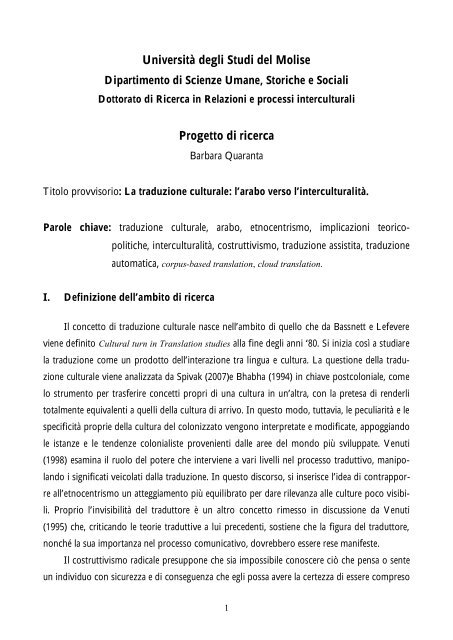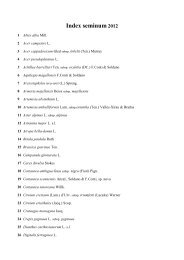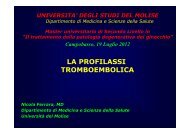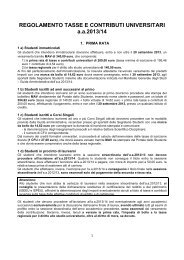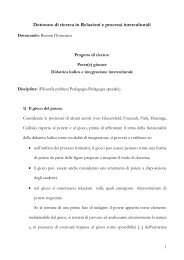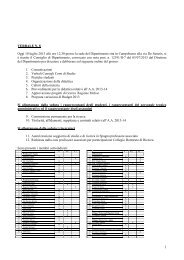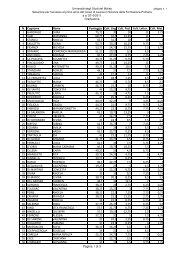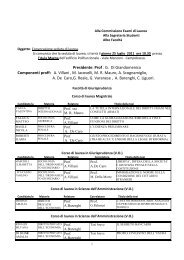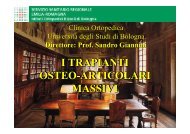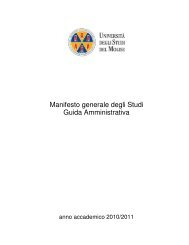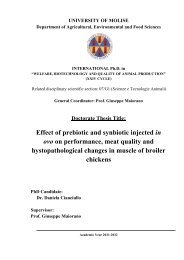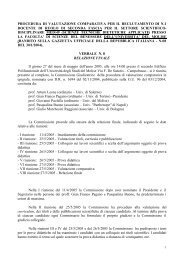Progetto di ricerca dott.ssa Barbara Quaranta - Università degli Studi ...
Progetto di ricerca dott.ssa Barbara Quaranta - Università degli Studi ...
Progetto di ricerca dott.ssa Barbara Quaranta - Università degli Studi ...
Create successful ePaper yourself
Turn your PDF publications into a flip-book with our unique Google optimized e-Paper software.
Università <strong>degli</strong> Stu<strong>di</strong> del MoliseDipartimento <strong>di</strong> Scienze Umane, Storiche e SocialiDottorato <strong>di</strong> Ricerca in Relazioni e processi interculturali<strong>Progetto</strong> <strong>di</strong> <strong>ricerca</strong><strong>Barbara</strong> <strong>Quaranta</strong>Titolo provvisorio: La traduzione culturale: l’arabo verso l’interculturalità.Parole chiave: traduzione culturale, arabo, etnocentrismo, implicazioni teoricopolitiche,interculturalità, costruttivismo, traduzione assistita, traduzioneautomatica, corpus-based translation, cloud translation.I. Definizione dell’ambito <strong>di</strong> <strong>ricerca</strong>Il concetto <strong>di</strong> traduzione culturale nasce nell’ambito <strong>di</strong> quello che da Bassnett e Lefevereviene definito Cultural turn in Translation stu<strong>di</strong>es alla fine <strong>degli</strong> anni ‘80. Si inizia così a stu<strong>di</strong>arela traduzione come un pro<strong>dott</strong>o dell’interazione tra lingua e cultura. La questione della traduzioneculturale viene analizzata da Spivak (2007)e Bhabha (1994) in chiave postcoloniale, comelo strumento per trasferire concetti propri <strong>di</strong> una cultura in un’altra, con la pretesa <strong>di</strong> renderlitotalmente equivalenti a quelli della cultura <strong>di</strong> arrivo. In questo modo, tuttavia, le peculiarità e lespecificità proprie della cultura del colonizzato vengono interpretate e mo<strong>di</strong>ficate, appoggiandole istanze e le tendenze colonialiste provenienti dalle aree del mondo più sviluppate. Venuti(1998) esamina il ruolo del potere che interviene a vari livelli nel processo traduttivo, manipolandoi significati veicolati dalla traduzione. In questo <strong>di</strong>scorso, si inserisce l’idea <strong>di</strong> contrapporreall’etnocentrismo un atteggiamento più equilibrato per dare rilevanza alle culture poco visibili.Proprio l’invisibilità del traduttore è un altro concetto rimesso in <strong>di</strong>scussione da Venuti(1995) che, criticando le teorie traduttive a lui precedenti, sostiene che la figura del traduttore,nonché la sua importanza nel processo comunicativo, dovrebbero essere rese manifeste.Il costruttivismo ra<strong>di</strong>cale presuppone che sia impossibile conoscere ciò che pensa o senteun in<strong>di</strong>viduo con sicurezza e <strong>di</strong> conseguenza che egli po<strong>ssa</strong> avere la certezza <strong>di</strong> essere compreso1
Recent research on translation memories and machine translation technologies tends to focus on technicalissues only, falsely abstracting the technologies from the many <strong>di</strong>fferent social situations in which theyare ostensibly to be used. At the same time, the revolutionary promise of the systems with learning potentialis that they will improve output only with widespread use, and thus only through the involvement of <strong>di</strong>fferentgroups of social users. In principle, humanistic research is well positioned to investigate and communicatebetween the various users, with awareness of <strong>di</strong>fferent kinds of social actors, collaborative workflows, texttypes, and translation purposes. If knowledge on those variables can be fed back into the technical researchand development, humanistic research could play a key role in enhancing not only the social impact of thetechnologies, but also their democratization.In quanto mezzi che favoriscono il processo traduttivo inseriti in un mercato economicointernazionale, gli strumenti per la traduzione assistita, automatica e corpus-based vengono realizzatitenendo conto delle istanze e delle necessità avvertite nelle aree più sviluppate del mondo,lasciando in secondo piano lingue e culture meno rilevanti dal punto <strong>di</strong> vista economico epolitico. Tali strumenti <strong>di</strong> traduzione sono appositamente creati per lingue occidentali e vengonosuccessivamente adattati anche a quelle non-occidentali. Tuttavia, le lingue non occidentalinon sono sempre internamente strutturate come quelle occidentali, né possono essere facilmentericon<strong>dott</strong>e o assimilate a modalità <strong>di</strong> funzionamento universali.A titolo esemplificativo, ci si riferisce ai problemi riscontrati nella traduzione <strong>di</strong> testi arabicon gli strumenti <strong>di</strong> traduzione assistita, derivanti dal carattere estremamente flessivo e morfologicamentericco dell’arabo. Un’ulteriore prova <strong>di</strong> queste tendenze riguarda la <strong>di</strong>gitalizzazionedelle lingue non occidentali e, nello specifico, lo sviluppo e la <strong>di</strong>ffusione dell’Arabish, ovverodella traslitterazione della lingua araba tramite caratteri e numeri dell’alfabeto latino, data la <strong>di</strong>fficoltà<strong>di</strong> utilizzare e <strong>di</strong> reperire siti web e applicazioni completamente compatibili con alfabeti<strong>di</strong>versi da quello latino.III.Novità che si intendono apportare in riferimento ai problemi aperti identificatiL’obiettivo che ci si prefigge <strong>di</strong> raggiungere in prima istanza è quello <strong>di</strong> analizzare il concetto<strong>di</strong> traduzione alla luce <strong>di</strong> approcci quali il costruttivismo e la filosofia interculturale, al fine<strong>di</strong> colmare la <strong>di</strong>stanza tra la pratica e la teoria della traduzione. Stu<strong>di</strong> recenti ipotizzano la nascita<strong>di</strong> una sociologia della traduzione, allo scopo <strong>di</strong> supportare le indagini e l’evoluzione delle innovazionitecnologiche con stu<strong>di</strong> relativi alla cultura (Pym, 2011).4
VIII. Bibliografia <strong>di</strong> riferimento Bassnett, S., and Lefevere, A., (1990), Translation, History and Culture, Pinter, London& New York; Benjamin, W., (2000), The Task of the Translator, translated by H. Zohn (1969), in L.Venuti (ed.), pp. 75-82; Ben Amara, R., (2009), Language and Cultural Translation: an exile & a permanenterrance, Aracne, Roma, 2009; Berger, P. L., Luckmann, T., (1969), La realtà come costruzione sociale, il Mulino, Bologna; Berman, A., (2000) ‘Translation and the trials of the foreign’, translated by L. Venuti, inL. Venuti (ed.), pp. 284-97; Bhabha, H., (1994), The Location of Culture, Routledge, London & New York; Derrida, J., (1985), «Des Tours de Babel», in J. F. Graham (ed.), Difference in Translation,pp. 165-207; Derrida, J., (2001), «What is a ‘relevant’ translation? », translated by L. Venuti, CriticalInquiry, Vol. 27, No. 2, Inverno, 2001, pp. 174-200; Fabris, A., (a cura <strong>di</strong>), (2002), Comunicazione e me<strong>di</strong>azione interculturale: prospettive aconfronto, ETS, Pisa; Gadamer, H.G., (1983),Verità e Metodo, Bompiani, Milano; Mall, R. A., (2000), Intercultural Philosophy, Rowman & Littlefield Publishers; Monceri, F. e Gili, G, (a cura <strong>di</strong>), (2009), Comprendersi o no: significati e pratiche dellacomunicazione interculturale, Aracne, Roma,; Monceri, F., (2006), Interculturalità e comunicazione. Una prospettiva filosofica, E<strong>di</strong>zioniLavoro, Roma; Monceri, F., (2008), Or<strong>di</strong>ni costruiti, Rubbettino, Soveria Mannelli; Munday, J., (2001), Introducing Translation Stu<strong>di</strong>es: theories and applications,Routledge, London & New York; Niranjana, T., (1992), Siting Translation: history, post-structuralism, and the colonialcontext, University of California Press, Berkeley, Los Angeles, Oxford;6
Poerksen, B., (2004), The certainty of uncertainty: <strong>di</strong>alogues introducing constructivism,Imprint Academic, Exeter, UK; Pym, A., (2011), Democratizing translation technologies – the role of humanistic research,Procee<strong>di</strong>ngs of the Luspio Automation Translation Conference, Rome, April2011; Pym, A., (2009), Exploring Translation Theories, Routledge, London & New York; Pym, A., (2003), «Globalization and the Politics of Translation Stu<strong>di</strong>es», paper deliveredto the conference Translation and Globalization (Cana<strong>di</strong>an Association of TranslationStu<strong>di</strong>es) in Halifax, Canada, 29 May 2003; Pym, A., (1995) «Schleiermacher and the Problem of Blendlinge», Translation and Literaturepp. 5-30; Spivak, G. C., (2007), «Translation as culture», in In Translation – Reflections, Refractions,Transformations, St-Pierre, Paul and Prafulla C. Kar (eds.), Benjamins TranslationLibrary, pp. 263 - 276; Spivak, G. C., (2000), «The politics of translation», in L. Venuti (ed.), The TranslationStu<strong>di</strong>es Reader, Routledge, London and New York, pp. 397 - 416; Steiner, G., (1998), After Babel: aspects of language & translation, Oxford UniversityPress, third e<strong>di</strong>tion; Trive<strong>di</strong>, H., (2007), «Translating culture vs. cultural translation», in In Translation – Reflections,Refractions, Transformations, St-Pierre, Paul and Prafulla C. Kar (eds.), BenjaminsTranslation Library, pp. 277 - 287; Tymoczko, M., (1999),Translation in a Postcolonial Context. Early Irish Literature inEnglish Translation, St. Jerome Publishing, Manchester; Venuti, L., (1998), The Scandals of Translation: towards an ethics of <strong>di</strong>fference,Routledge, London and New York; Venuti, L., (1995), The Translator’s Invisibility: a history of translation, Routledge,London and New York, Venuti, L., (2004), The Translation Stu<strong>di</strong>es Reader, Routledge, London and New York; Wolf, M. e Fukari, A., (2007), Constructing a Sociology of Translation, BenjaminsTranslation Library, Amsternam/Philadelphia.7
IX.Bibliografia acquisita non ancora consultata Alvarez, R. e Vidal M. C.-A. (eds.), (1996), Translation, Power, Subversion. Clevedon:Multilingual Matters; Chiari, I., (2007), Introduzione alla linguistica computazionale, Bari: Laterza; Darwish, K., Diab, M., e Habash, N., (2005), Procee<strong>di</strong>ngs of the ACL Workshop onComputational Approaches to Semitic Languages, Ann Arbor, Michigan: Associationfor Computational Linguistics; Hale, B. e Wright, C. (eds.), (1997), A companion to the philosophy of language, Blackwell,Oxford; Hardwick, Lorna (2000), Translating Words, Translating Cultures, London:Duckworth; Hatim, B. (2000), Communication across cultures. Translation theory and contrastivetext linguistics, University of Exeter Press; Hatim, B., (2001), Teaching and Researching Translation, Harlow: Longman; Katan, D., (1999), Translating cultures: an introduction for translators, interpreters andme<strong>di</strong>ators, Manchester: St. Jerome; Kelly, L. G., (1979), The True Interpreter: A History of Translation Theory and Practicein the West , Oxford: Blackwell; Muschard, J., (1996), Relevant Translations: History, Presentation, Criticism, Application,Frankfurt am Main, Peter Lang; Neumann, G., Van Den Bosch, A. e Abdelha<strong>di</strong>, S. (eds.), (2007), Arabic MorphologicalAnalysis: Knowledge-based and Empirical Methods, Springer, The Netherlands; Pym, A., (1992), Translation and Text Transfer: An E<strong>ssa</strong>y on the Principles of InterculturalCommunication, Frankfurt am Main, Peter Lang; Robinson, D., (1997), Western Translation Theory From Herodotus to Nietzsche, Manchester,St. Jerome Publishing; Robinson, D. (1997), Translation and Empire: Postcolonial Theories Explained, Manchester,St. Jerome Press; Schulte, R. e Biguenet, J. (eds.), Theories of Translation: An Anthology of E<strong>ssa</strong>ys fromDryden to Derrida, Chicago, University of Chicago Press;8
Snell- Hornby, M. (1995), Translation Stu<strong>di</strong>es. An Integrated Approach, Amsterdam,John Benjamins; Venuti, L., (ed.) (1992), Rethinking Translation: Discourse, Subjectivity, Ideology, London,Routledge; Wittgenstein, L., (1963), Philosophical Investigations, Blackwell, Oxford.9


